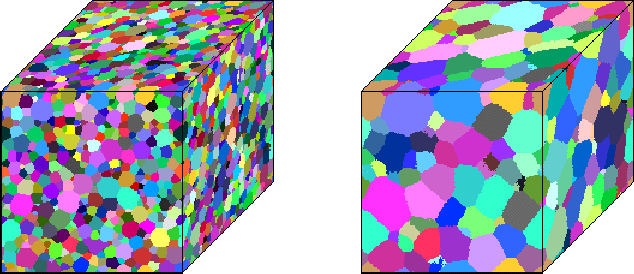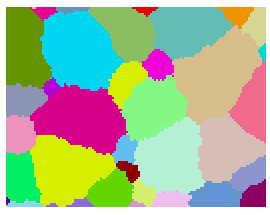|
Grain Growth |
|
The grain microstructure is an important feature of polycrystalline solids [Allen and Thomas (1999); Rohrer (2001); Henkel and Pense (2002); Dove (2003)]. The control of the microstructure is a key to improve the material’s properties in processing, like e.g. strength, toughness, diffusivity and electrical conductivity. Therefore, it is very important to predict the grain microstructure and its time evolution due to processes like recrystallization and grain growth (compare [Humphreys and Hatherly (1995); Novikov (1997); Raabe (1998); Gottstein (2004)] and conference proceedings e.g. [Weiland et al. (1998); Gottstein and Molodov (2001); Bacroix et al. (2004)]). Grain growth occurs as the result of grain boundary energy driven grain boundary migration, where the thermodynamic driving force is the decrease in the Gibbs free interface energy. This process is also called grain coarsening [van Bueren (1960)] and describes the growth of the mean grain size with a simultaneous decrease in the total inner interface, which leads to a minimization of the total interface free energy. In order to study the phenomenon of grain growth more closely Smith (1952) and Burke and Turnbull (1952) developed the first physically motivated grain growth models. However, there were still clear discrepancies between the theories and experiments.  Figure 1: 3D grain structures taken from different time steps of the coarsening process. Beginning in the 1980s, there have been made many attempts to model the grain microstructure and especially the microstructural evolution under realistic conditions with the help of computer simulations (e.g. [Anderson et al. (1984)]), which have provided a new approach. Goals of all these computer simulations are
 Figure 2: 2D grain structure taken from the coarsening process. Until lately two-dimensional (Fig. 2) grain growth models were the dominating ones because of the complexity and time-expense of three-dimensional computer simulations. But especially the last years have opened up growing possibilities of the investigation of three-dimensional grain growth due to the fast development in computer science. For each of the above methods there can be found a large number of publications describing implementations, advantages and two- and three-dimensional simulation results. A survey of the most important simulation methods is for example given in [Miodownik (2002)] whereas review articles regarding not only models and computer simulations but also classical theories have been written by Atkinson (1988) and Thompson (2001). |
| [Allen and Thomas (1999)] | S.M. Allen and E.L. Thomas. The structure of materials. Wiley, New York, 1999. |
| [Rohrer (2001)] | G.S. Rohrer. Structure and bonding in crystalline materials. Cambridge University Press, 2001. |
| [Henkel and Pense (2002)] | D. Henkel and A.W. Pense. Structure and properties of engineering materials. McGraw-Hill, Boston (Mass.), 2002. |
| [Dove (2003)] | M.T. Dove. Structure and dynamics: an atomic view of materials. Oxford University Press, 2003. |
| [Humphreys and Hatherly (1995)] | F.J. Humphreys and M. Hatherly. Recrystallization and related annealing phenomena. Pergamon Press, Oxford, 1995. |
| [Novikov (1997)] | V. Novikov. Grain growth and control of microstructure and texture in polycrystalline materials. CRC Press, BocaRaton, 1997. |
| [Raabe (1998)] | D. Raabe. Computational materials science: The simulation of materials, microstructure and properties. Wiley-VCH, Weinheim, 1998. |
| [Gottstein (2004)] | G. Gottstein. Physical foundations of materials science. Springer, Berlin, 2004. |
| [Weiland et al. (1998)] | H. Weiland, B.L. Adams, and A.D. Rollett. Grain growth in polycrystalline materials III. TMS, Warrendale (PA), 1998. |
| [Gottstein and Molodov (2001)] | G. Gottstein and D.A. Molodov. Recrystallization and grain growth. Springer, Berlin, 2001. |
| [Bacroix et al. (2004)] | B. Bacroix, J.H. Driver, R. Le Gall, Cl. Maurice, R. Penelle, H. Réglé, and L. Tabourot. Recrystallization and grain growth, volume 467–470. Trans Tech Publications, Uetikon-Zürich, 2004. |
| [van Bueren (1960)] | H.G. van Bueren. Imperfection in Crystals. North-Holland Publication Co., 1960. |
| [Smith (1952)] | C.S. Smith. Seminar Report (Cleveland, Ohio: American Society for Metals). Metal Interfaces, page 65, 1952. |
| [Burke and Turnbull (1952)] | J.E. Burke and D. Turnbull. Recrystallization and grain growth. Progress in Metal Physics, 3:220, 1952. |
| [Anderson et al. (1984)] | M.P. Anderson, D.J. Srolovitz, G.S. Grest, and P.S. Sahni. Computer simulation of grain growth – 1. Kinetics. Acta Metallurgica, 32:784, 1984. |
| [Miodownik (2002)] | M.A. Miodownik. A review of microstructural computer models used to simulate grain growth and recrystallisation in aluminium alloys. Journal of Light Metals, 2:125, 2002. |
| [Atkinson (1988)] | H.V. Atkinson. Theories of normal grain growth in pure single phase systems. Acta Metallurgica, 36:469, 1988. |
| [Thompson (2001)] | C.V. Thompson. Grain growth and evolution of other cellular structures. Solid State Physics, 55:269, 2001. |
| [Zöllner (2006)] | D. Zöllner. Monte Carlo Potts Model Simulation and Statistical Mean-Field Theory of Normal Grain Growth. Shaker-Verlag, Aachen, 2006. |
Datenschutzerklärung der Otto-von-Guericke-Universität Magdeburg nach DSGVO